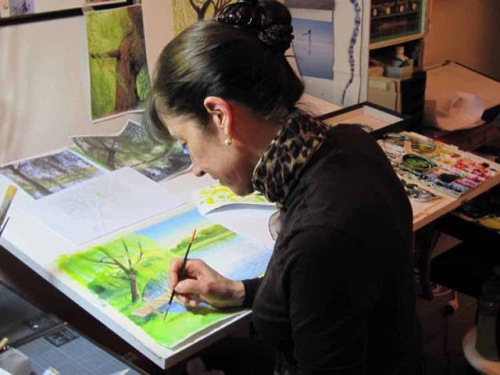
Jeanne de Sainte Marie attended Fine Art and Textile De-sign at the University of Michigan, then the Ecole des Arts Décoratifs in Paris. She designed colors and materials for cars, Jeeps and buses in Detroit. In France, she designed for Renault. Until recently, one of her fabric designs adorned the seats on Paris city buses.
Her wings took her off to Europe, Japan and North Africa, where her professional voyage continued. She free-lanced, created Advent calendars, CD covers, posters and periodicals.
One day when her sons were young, she came across a handmade book that she had made and illustrated when she was 12. It was her version of the poem, Travel from a favorite childhood book: Robert Louis Stevenson’s, A Child’s Garden of Verses.
This started her dreaming. She dreamed of and worked at creating her own books that would be published and that would open windows to new worlds. Each time she sat at her drawing board a new journey began.
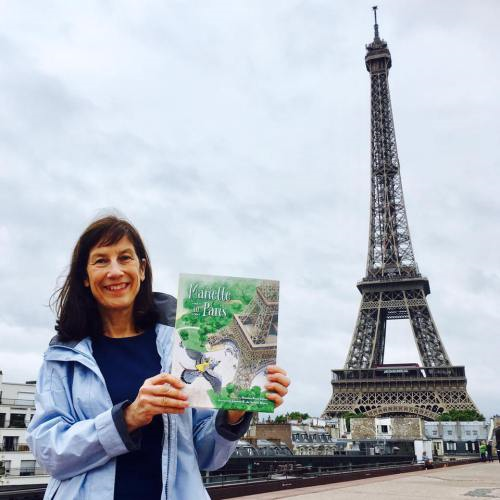
Here is Jeanne discussing her process:
I often set up objects or make models in my studio to draw. I also use photos. Here are some I used for the nighttime flowerpot watercolor.

I often set up objects or make models in my studio to draw. I also use photos. Here are some I used for the nighttime flowerpot watercolor.

The character’s name changed from Monique to Margo, then Mirabelle to Marielle. (that’s a long story, in itself…)
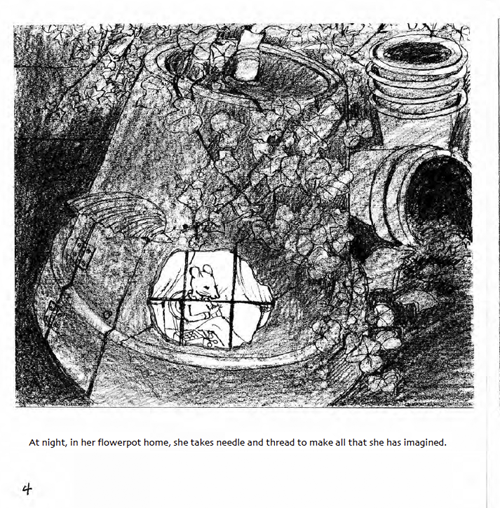
Adding some dark values for a night look.
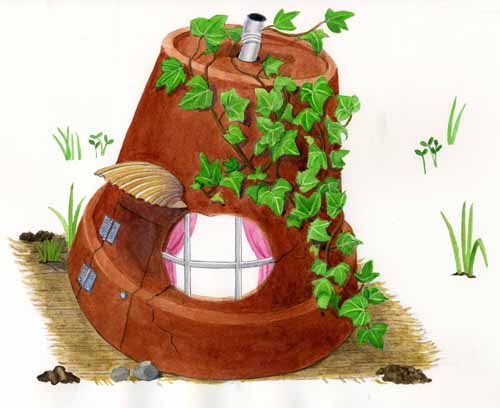
I don’t usually do my book illustrations in so many pieces, but I had two reasons to do it for this picture: an app developer wanted to do an animation sample with the mouse sewing in the window and because night scenes in watercolor are tricky.
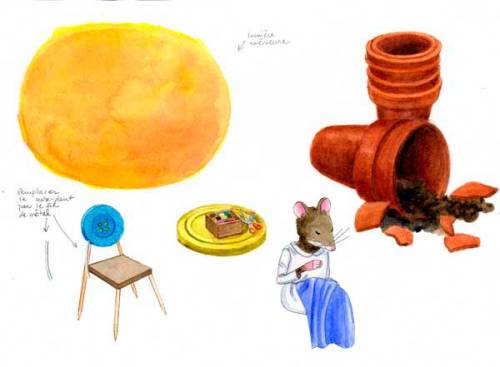
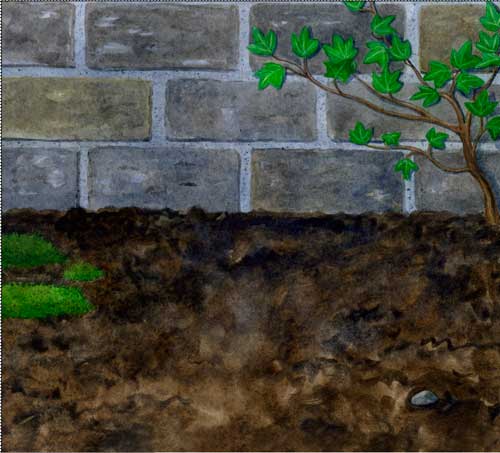
Dark colors can get very muddy if one is not careful. By doing it in pieces, I could scan them, mount them in layers and adjust colors as I went along.
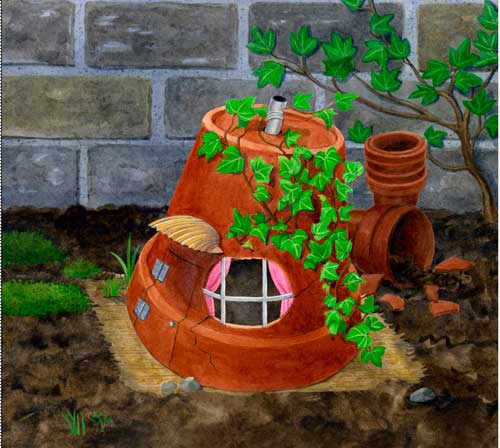
Finished Illustration in book (below)
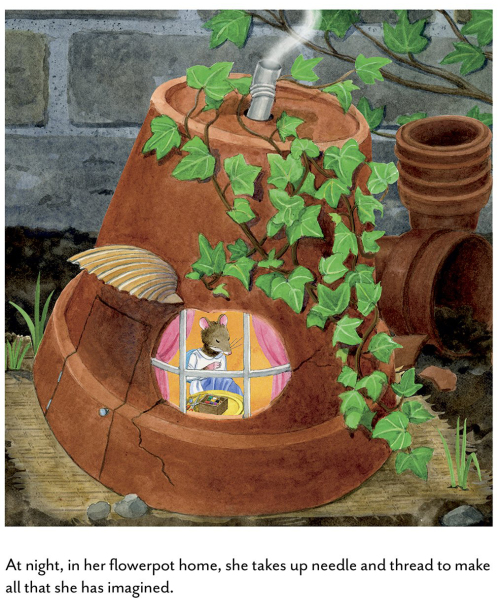
Interview with Jeanne de Sainte Marie:
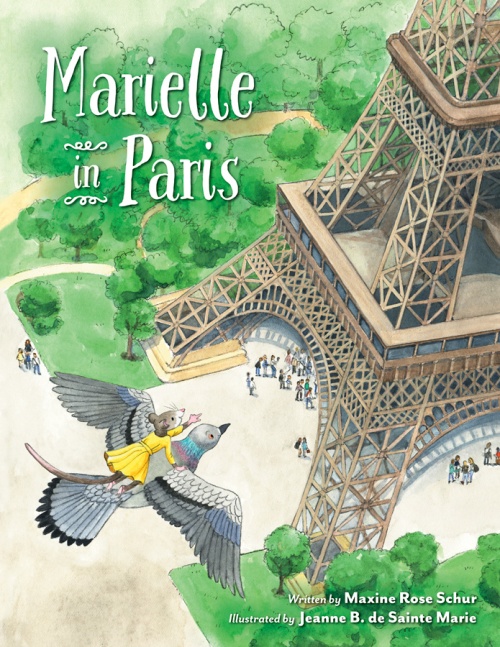
How long have you been illustrating?
I had a light bulb moment one day in 1990 after the birth of our second son. I wanted to illustrate children’s books! I had been working as an automotive color and materials designer, first in the U.S., then in France. I enjoyed my work as a designer, but I was never passionate about cars, like I have always been about books. Having children made me re-assess what was important to me and to future generations. I joined SCBWI and began building a suitable portfolio and also writing stories.
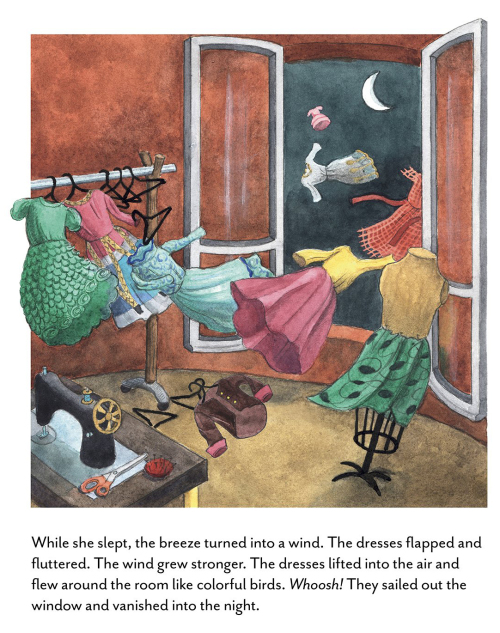
What and when was the first painting or illustration that you did where someone paid you for your artwork?
In the 70s, for a summer job I was hired to paint a series of panels in oil paint for a circus organ!
I had to stick to the genre: landscapes, cupids, flowers and such.
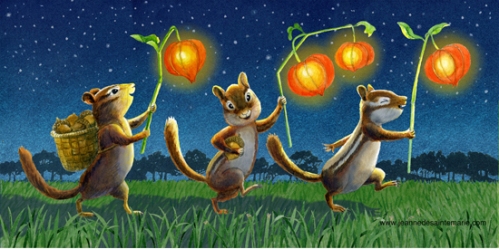
What made you choose to attend the Fine Art and Textile De-sign at the University of Michigan?
I always knew I wanted to be “an artist”, but I didn’t really know what that meant in terms of a career. I was a good student and wanted to make art as well as take interesting classes about other subjects. As a Michigan resident at the time, U of M was a top-tier university with a lot of cultural offerings and available to me at a not too outrageous price.

What types of classes did you take?
I was as an Art Major, but also took classes in French, Literature, and Art History. After the basic art classes, I did mostly painting (pretty abstract) until I discovered silk-screening, which I loved. I printed on paper and on fabrics and that was the springboard to doing more with textiles.
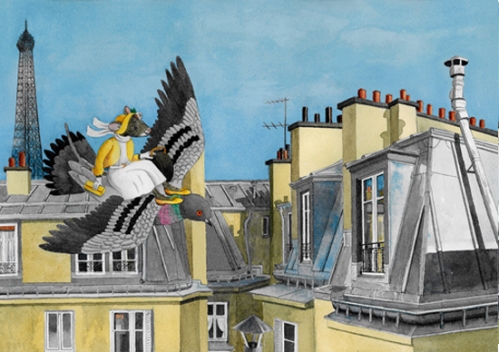
What made you move to France? Was it to study art?
My parents always pronounced my first name (Jeanne) the French way, because they were both of French Canadian origin and grew up in Lowell, Massachusetts where there is a “Little Canada” community. My father, born in the U.S., spoke French before he spoke English. My maiden name (Belanger) is French too. With this influence from my family and my idealized image of Paris and the artistic ‘ bohemian’ life I imagined living there, I decided to study art in Paris. U of M had a Junior year abroad program in Aix-en-Provence, but I discovered that I could enroll directly in a French art school, so that’s what I did. I spent one year at the Ecole normale supérieure des arts décoratifs (decorative arts school) and then returned to U of M to finish my studies. Years later I returned as an automotive designer to work for the French car company, Renault.
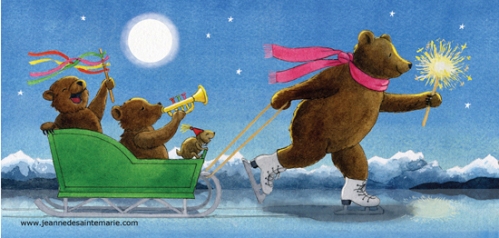
Do you think art school influenced your style?
What I do now is very different than the “fine art” I did back then in the 70’s. Little emphasis was placed on classical drawing skills; we were encouraged to “express ourselves”. Abstract and conceptual art were encouraged. In retrospect, I might have preferred an applied arts or illustration school, but I don’t dwell on this idea, because there are many different paths to learning. I certainly learned things about composition, color, flow and the art world in general and those are stylistic influences. In later years I took some evening drawing classes, taught myself watercolor painting by copying from books and just kept on doing my thing.

What type of job did you do right after you graduated?
My first job was as a window display artist. Shortly after, I landed a job in Detroit at American Motors Company to do color and Fabric “styling” (as they called it at the time). After 4 years, AMC sent me to work at the Renault. I could have gone back to Detroit, but decided to stay in Paris.
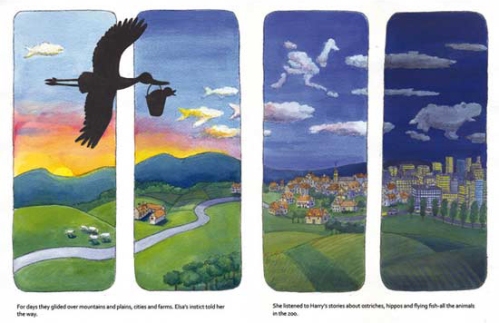
Do you still live in France?
Yes!
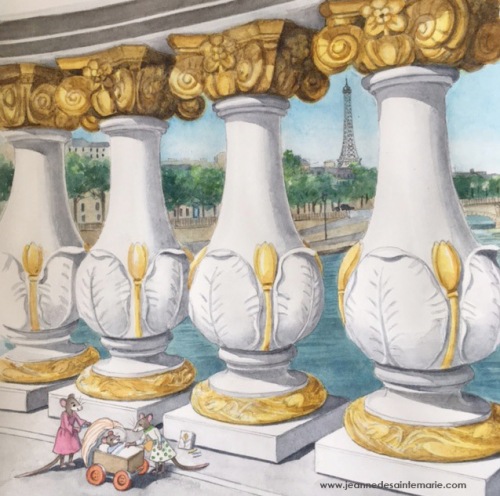
How many picture books have you illustrated?
I have illustrated 4 books, three book apps and countless projects such as Advent calendars, posters, magazine illustration, t-shirts…
One of the iPAd app projects was entitled A Word’s A Bird, Spring Flies by In Rhymes. It is an interactive, bilingual (English and French) poetry app written by the very talented Orel Protopopescu. This app was literally made in a thousand pieces!
I first designed the characters, drew the storyboards and model sheets and researched all the animals and plants.
Then I did animation drawings for the characters (an average of 15 drawings per second of animation) and painted them on watercolor paper. The scenery is painted in watercolor as well. All the artwork was scanned, separated and programmed for the iPad by the French developer, Actailuna/Syntonie
The scenery is in pieces and mounted in layers, to allow flexibility for movement/animation. The layering also gives a wonderful impression of depth.
See our “Making-of” video:
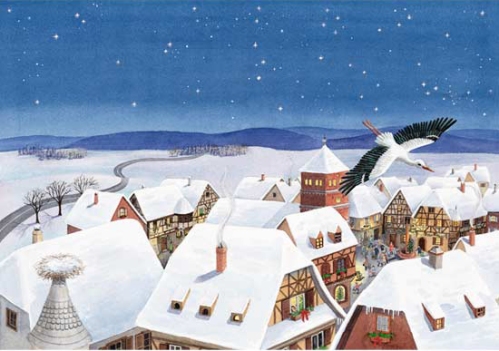
Last month we did a book giveaway of MARIELLE IN PARIS. How did that contract come your way?
I met the author, Maxine Rose Schur when she attended an informal SCBWI (Society of Children’s Book Writers and Illustrators) meeting in our apartment.
When Maxine saw some of my illustrations, they inspired her to write this charming children’s book about a Parisian mouse. Both the child and the adult in me felt akin to the Marielle character when I read it, so I did some sample illustrations. We both submitted to various publishers and were very happy when Pomegranate Communications decided to publish Maxine’s story with my illustrations!
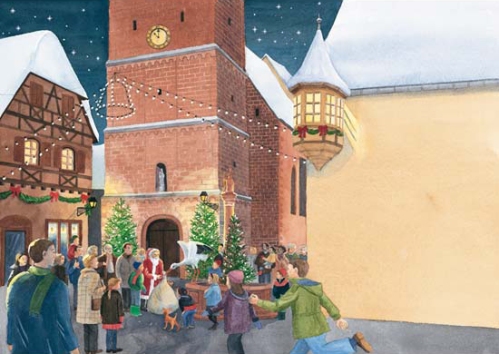
Is the publisher, Pomegranate, a French publisher?
Pomegranate is a wonderful American publisher!
http://www.pomegranate.com/a268.html
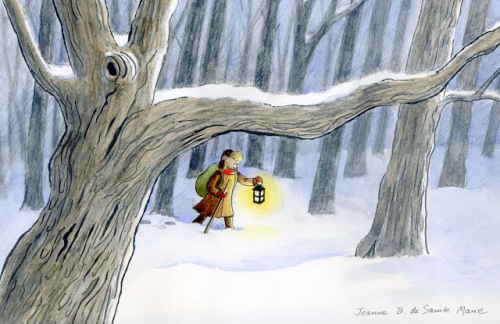
Do you have any desire to write and illustrate your own children’s book?
I have written and illustrated three of my books: Naviguez Plein Est au fil des canaux (a travel notebook about a trip on the canals in eastern France), La Cigogne de Noël (The Christmas Stork) and Yan Yan, le premier panda noir et blanc (Yan Yan, the First Black and White Panda).
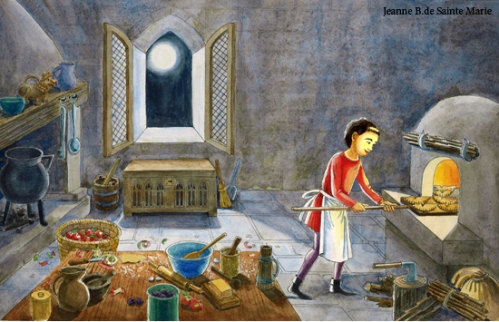
I love the cover of La Cigogne de Noël. Unfortunately, it is written in French. Have you ever thought of looking for an English language publisher?
Thanks! La cigogne de Noël exists in English as an animated iPad app from Auryn. It is called The Christmas Stork. I did not animate this app. The lovely animations were done by the publisher after I provided them with the English text and the illustration files from the original book.
https://itunes.apple.com/ca/app/the-christmas-stork/id946588983?mt=8
When I first sought a publisher for La Cigogne de Noël, I did send it out to American publishers. (I write all my stories in both French and English, to maximize my chances for finding publishers.) I was told it was too European or that it would be better to feature an American bird!
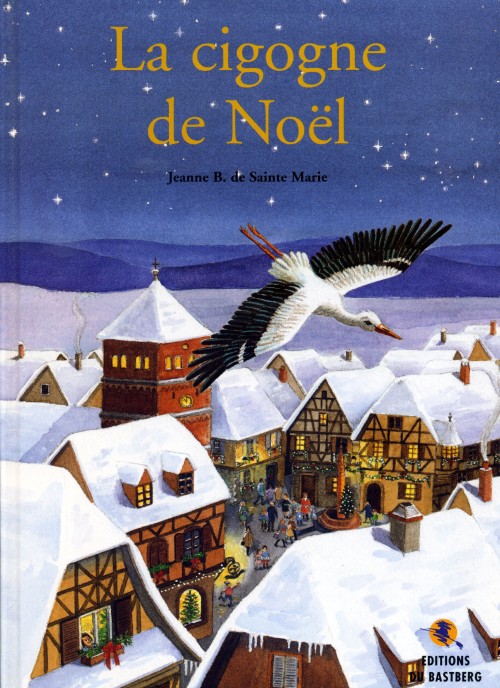
How did you get to illustrate Yan Yan le premier panda noir et blanc?
Les Editions du Bastberg, my publisher for La Cigogne de Noël, gave me a small summary about the Chinese legend which he cut out of a newspaper about how the panda came to be black and white. He asked me to write and illustrate a picture book of the story. I changed the story though, because in the legend a leopard kills a little girl who lives among the pandas. The pandas go to her funeral and rub away their tears after putting their paws in funeral ash. Years ago I took a two week workshop with Caldecott winner, author-illustrator Uri Shulevitz who strongly emphasizes the importance of a happy ending for picture books. I cut the funeral (and the little girl) out of the story. In the Chinese legend, the pandas lived in the land of “Sleeping Dragon Mountain”. This evoked a volcano to me and so since “In those days panda bears where all white…” the erupting volcano ash would provide the touches of black for Yan Yan. It is an initiation story.
Auryn apps also made animated apps in English of Yan Yan for iPad and iPhone.
https://itunes.apple.com/us/app/yan-yan-first-black-white/id947711772?mt=8

Have you done any book covers?
Yes, for my own books.
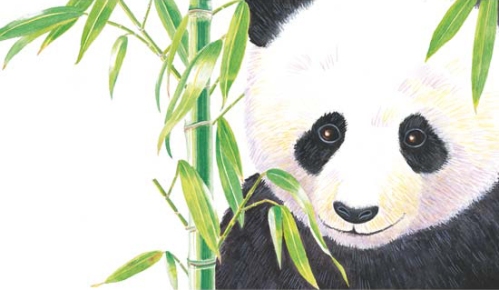
Would you be open to illustrating a book for an author who wants to self-publish?
Sorry, no.
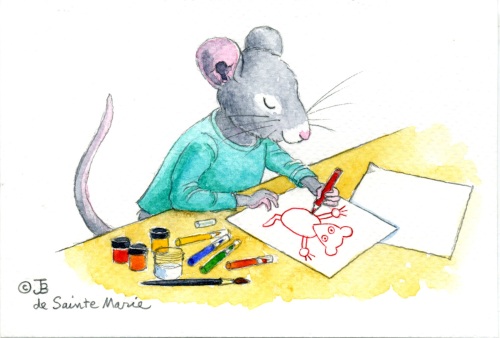
Have you worked with educational publishers?
No.
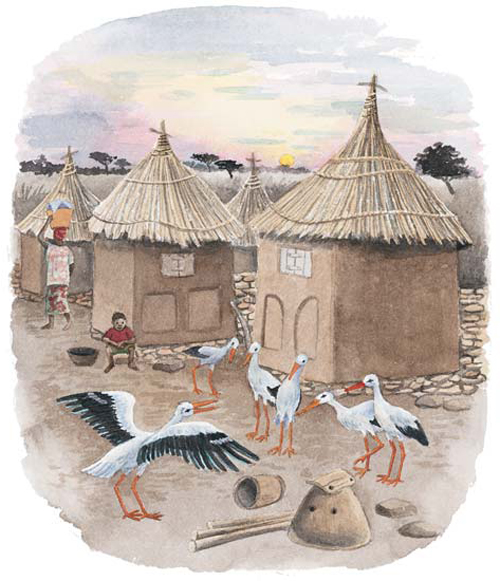
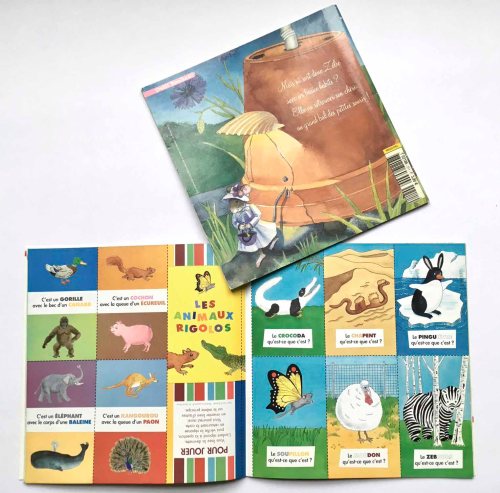
Have you done any illustrating for children’s magazines?
Yes, I have illustrated for French children’s magazines. Here is a photo of some “Abricot” magazines with my illustrations. One shows an animal card game to cut out and the other, a back-cover with a poem (This is one of the illustrations that Maxine saw when we met. The mouse character is different, but I used the idea of the flowerpot as a home for a mouse in the Marielle in Paris book.)
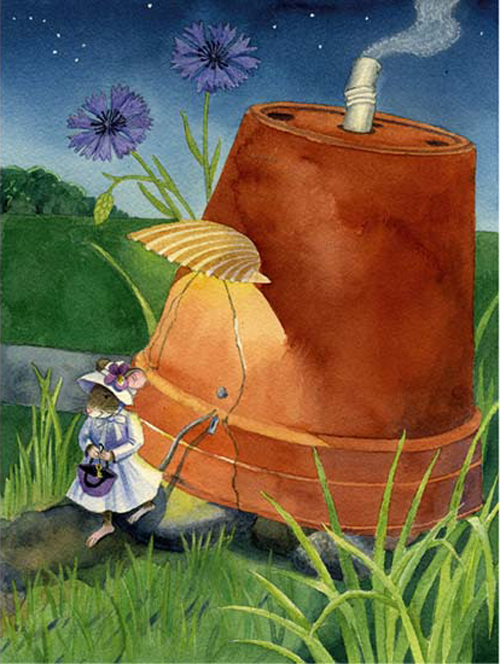
Have you tried to illustrate a wordless picture book?
I’m working on one now. I’ll let you know later how it works out!
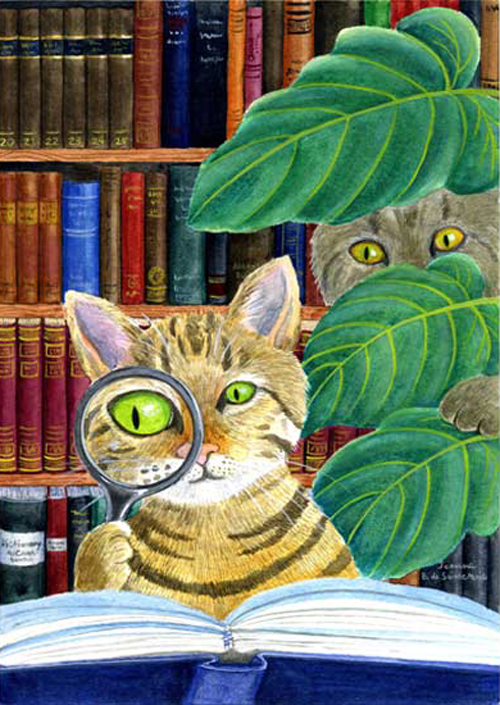
Do you have an artist rep. or an agent?
Yes, Erzsi Deak at Hen & Ink Literary Studio represents me.

How did you connect with them?
I was the first person that Erzsi called in 1995 when we founded the French branch of SCBWI. Years later when she set up her rep business, she invited me to join the Hen & Ink “coop”.

What types of things do you do to find illustration work?
For years, I have been attending SCBWI events to make contacts and learn the business. I go to book fairs mostly in France, but also Bologna and London. Via contacts an illustrator and author can find out who is looking for what, thus can target their submissions. Also, if you are sending your work out without an agent, a personal contact with an editor can possible get your work looked at faster than other works in the slush pile.
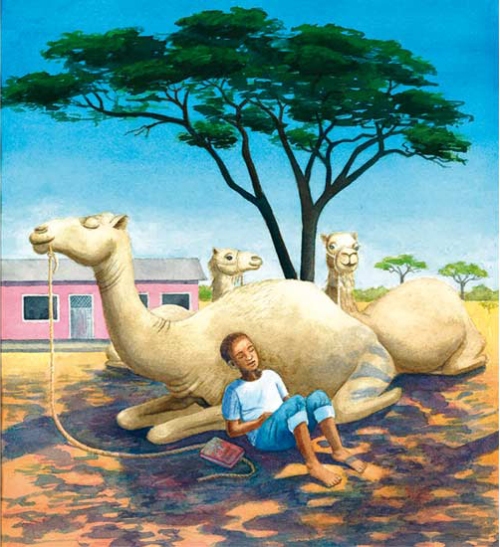
What is your favorite medium to use?
Watercolor, pen and pencil.
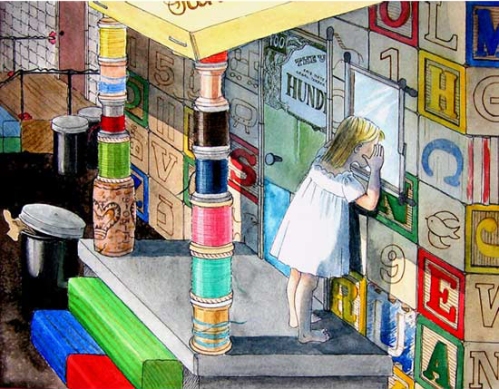
Has that changed over time?
I still work predominately with these media, but I now also use Photoshop. I am using some collage now too.
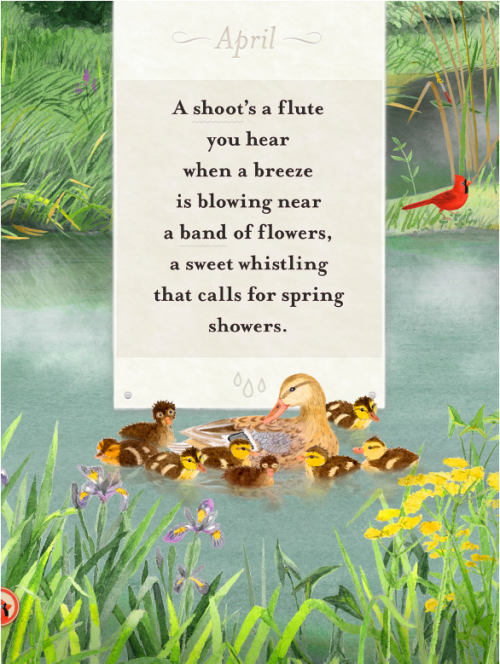
Do you have a studio set up in your home?
Yes, it is a room in our Paris apartment.

What is the one thing in your studio that you could not live without?
This may be your hardest question yet! The first thing that comes to mind is my pencil. Lately I use a mechanical pencil with re-chargeable leads. I got tired of sharpening pencils. But that is not a very exciting answer and my pencil moves in and out of my studio… For years I lived without a flat file to store paper. I used to store it vertically inside cardboard portfolios. Not very efficient! Now that I have a beautiful wooden flat file in my studio, I’d say that I wouldn’t live without it now. An artisan in France who is part of the Sennelier family made it. Sennelier is a beautiful, historically famous art supply store on the banks of the Seine in Paris. I recommend that you look at the second video on my friend Robert J. Blake’s website video page to “visit” the shop!
http://robertjblake.com/videos/ (Sennelier appears from 6:10 to 8:22. Watch the whole video to see Rob paint the bridges in Paris.)

Do you try to spend a specific amount of time working on your craft?
Not only do I try, but also I do! I work from 3 to 8 hours a day, depending on the season and on my projects.
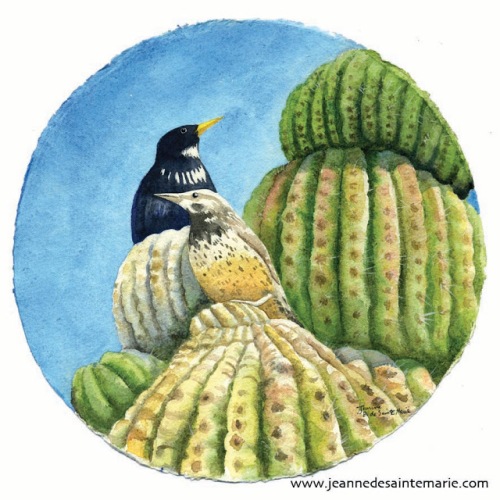

Do you take pictures or do any types of research before you start a project?
Yes, I do a lot of research (photographic and reading) for my projects. I find it is a fun and fascinating part of any project. Even when creating a fiction, I like things to be “credible”. For instance, when I did the stork book, I went to Alsace in eastern France to a center for the re-introduction of the stork. For a period they almost became extinct. I found out about their migratory instinct and trajectory, what they ate and their habits. I have seen illustrations of the European stork flying in the air with black tail feathers. Their tails are not black, but when standing with wings back, the black tip of the wings covers the tail. Someone didn’t do his or her research! I’ve even seen books with penguins at the North Pole! Things like that bug me.
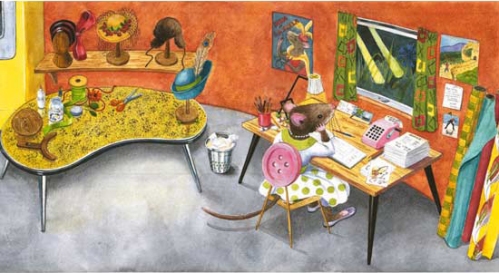
Do you think the Internet has opened doors for you?
Yes, it has made my work visible to people I do not know. For instance, out of the blue, The Telluride Gallery of Fine Art in Colorado contacted me, inviting me to exhibit in a children’s book illustration show “From Beasts to Babar” in 2011. I was honored to show my work alongside illustrators such as Laurent de Brunhoff, Maurice Sendak, Gennady Spirin, Peter Mcarty,Tomie de Paula, Peter Sis…
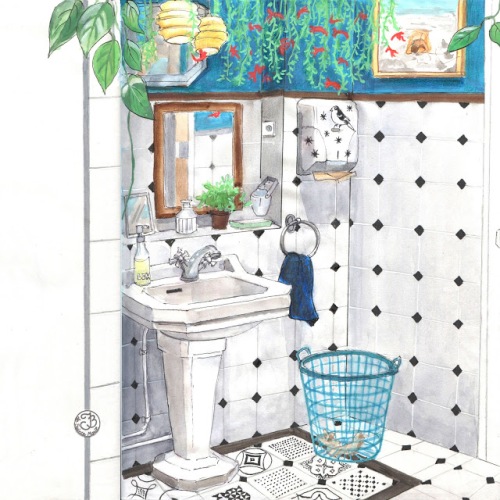
Do you use Photoshop or Painter with your illustrations?
Photoshop. For the Marielle in Paris book, scale was a problem throughout. I had to show some of the grandeur of Paris with a tiny mouse character as the star. I often painted the character separately on a larger scale than I finally used in the book, then reduced the size and photo-shopped her on to the background.
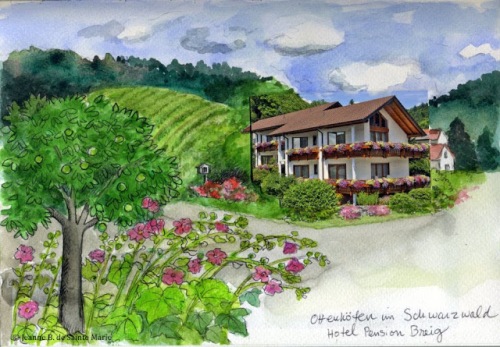
Do you own or have you used a Graphic Drawing Tablet in your illustrating?
Yes I have a Wacom tablet. I purchased it and have used it ever since I did the animation work for A Word’s A Bird.
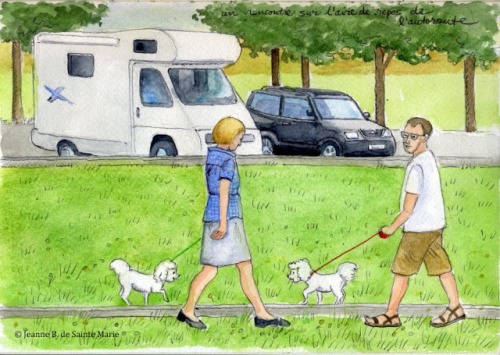
What are you working on now?
I’m re-working a picture-book dummy, adding collage and tweaking. Sketching a wordless picture book and preparing promotional events for November in San Francisco and Portland,OR. Watch my Facebook page @JustJeanneB for details about my upcoming appearances AND watch my @JustJeanneB Instagram account. For the whole month of November, I will run a #Marielledressdesign contest for kids. Parents and teachers can post their children’s drawings for a chance to win the Marielle in Paris book and an adorable cloth Marielle doll, made by my sister. She will sew up the winner’s design to clothe the doll!

Do you have any material type tips you can share with us? Example: Paint or paper that you love – the best place to buy – a new product that you’ve tried – A how to tip, etc.
I love Arches watercolor paper, usually fine grain, sometimes hot pressed if I have some fine detail. I use Winsor Newton or Sennelier watercolors. And I told you about the great Sennelier store!
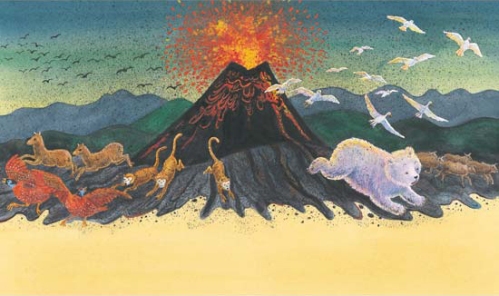
Any words of wisdom on how to become a successful writer or illustrator?
Love what you do. Be persistent. Think about different platforms for your work. Traditional books can be made into apps (or a movie, which would probably be more profitable!) Consider that you can sometimes sell the same project more than once in a different form or in a different market. For instance I designed an Advent calendar to a U.S. company, which only distributed only in the U.S. I made sure in the contract that they had U.S. and Canadian rights only. When I moved to France, I sold the same design to a French company.
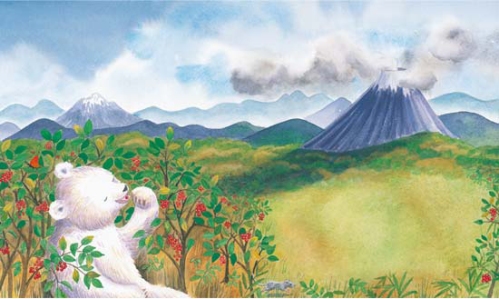
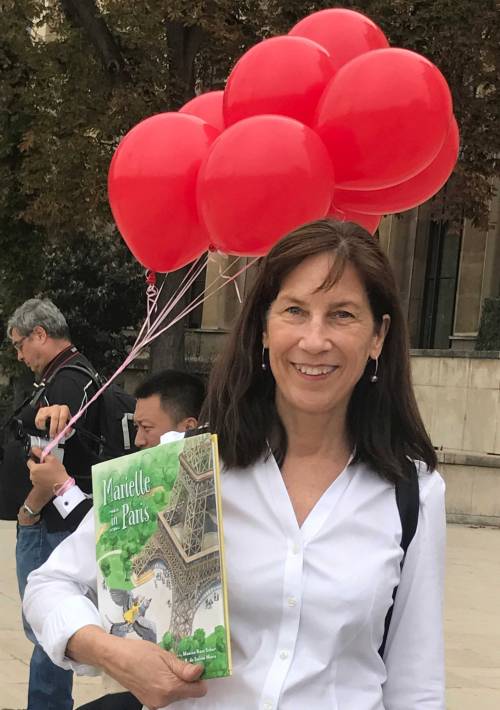
Thank you Jeanne for sharing your talent, process, journey, and expertise with us. Please make sure you keep in touch and share your future successes with us. To see more of Jeanne’s work, you can visit her at her website: http://www.jeannedesaintemarie.com/
If you have a minute, please leave a comment for Jeanne. I am sure she’d love it and I enjoy reading them, too. Thanks!
Talk tomorrow,
Kathy
what lovely work!
LikeLiked by 1 person
By: ksbeth on October 28, 2017
at 5:32 am
Thanks, ksbeth!
LikeLiked by 1 person
By: Jeanne de Sainte Marie on November 1, 2017
at 5:02 am
Your work is beautiful!! Thank you for the interview, Jeanne!
LikeLiked by 1 person
By: tiemdow on October 28, 2017
at 9:57 am
Thanks, tiemdow!
LikeLike
By: Jeanne de Sainte Marie on November 1, 2017
at 5:03 am
I enjoyed “meeting” you in this interview. Although not an artist, I like reading about this side of picture books. And I’m very interested in your lovely book about Marielle! And Paris!
LikeLiked by 1 person
By: Carleen M. Tjader on October 28, 2017
at 10:29 am
Thanks for your comment Carleen M. Tjader. Love your hat!
LikeLike
By: Jeanne de Sainte Marie on November 1, 2017
at 5:05 am
I sat in bed this morning with a cup of tea and thoroughly enjoyed this post, Jeanne. Your book looks adorable and that flowerpot, I’d love to have a house like that. Congratulations!
LikeLiked by 1 person
By: Kaye Baillie on October 28, 2017
at 6:53 pm
Thank you for starting your day reading about me, Kaye Baillie!
LikeLike
By: Jeanne de Sainte Marie on November 1, 2017
at 5:07 am
Jeanne, your work is so beautiful and I always love seeing process 🙂 I especially enjoyed learning about your U.S./French/Canadian background and your journeys between continents. It all sound so full and rick 🙂 Thanks for sharing (and now I will, too, on Twitter and Facebook :D)
LikeLiked by 1 person
By: writersideup on October 31, 2017
at 1:09 pm
Thank you, Writersideup. Your comment, sunshine and smiley faces make my day!
LikeLike
By: Jeanne de Sainte Marie on November 1, 2017
at 5:09 am